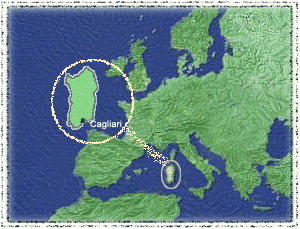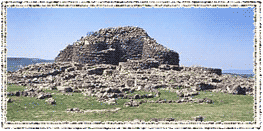Where we are
 Sardinia is the second biggest island in the Mediterranean sea (the biggest is Sicily). It is located between the Italian peninsula, Africa, France and Spain.
Sardinia is the second biggest island in the Mediterranean sea (the biggest is Sicily). It is located between the Italian peninsula, Africa, France and Spain.
Sardinia is above all a Mediterranean region rather than European. Its history is especially connected with the Arabian populations facing the Mediterranean sea. The ancient Greeks called it Ichnusa, from ichnon which means trace, for its shape similar to a human footprint. Another Greek name was Sandalion or Sandaliotis which means “island having a sandal shape”.
On the other hand, Sardinia, a Latin word, comes from Sardus Pater a Libyan hero who is said to have occupied the island. Traces of his cult remain in some archaeological monuments (for instance the Antas temple).
The Sardinian language is an intermediate form between the Oriental Romance languages (Italian and Rumanian) and the Western Romance languages (French-Provential, Catalan - Spanish - Portuguese). Dante Alighieri himself in his De Vulgari Eloquentia analyses Sardinia and writes: “grammaticam tanquam simiae homines imitantes; nam domus nova et dominus meus locuntur” (book I, chap. 11). That shows that in 1300 Sardinian was already recognized as a linguistic entity though very similar to Latin.
The special individuality of Sardinian can already be recognized from ancient texts. These are official documents which contain many common words which are still used nowadays in Sardinian. (Carte volgari di Cagliari – Cagliari popular documents, written in Sardinian, but using the Greek alphabet; Condaghes from S. Maria di Bonarcado and from San Pietro di Silki, documents dating from XI to XIII centuries concerning commercial contracts or other legal documents). The effort to create a literary Sardinian language was made by Girolamo Araolla who wrote the poem “Sa vida, su martiriu et morte de sos gloriosos martires Gavino, Brothu et Gianuari” (The life, martyrdom and death of the glorious martyrs Gavino, Brothu and Gianuari) in 1582.
In-depth on the Sardinian language have been carried out by Max Leopold Wagner, a renowned linguist who also wrote an etymological dictionary of the Sardinian language.
Geologically, Sardinia is an ancient land. It contains formations dating from the Cambrian period. They rose together with the Spanish meseta and with the Hyères in Provence. These lands existed in the Western Mediterranean long before the Alps and Apennines emerged.

The history of Sardinia can be seen in its landscape as well as in the soul of its people. We must avoid the mistake (Massimo Pallottino, 1986) of confounding landscape with nature. The typical Sardinian landscape with its rocky highlands emerging among the low Mediterranean bush, stonewalls, herds, nuraghi has been created by man. It is the result of a stratification of civilisations lasting thousands of years.
The nuraghe is the most common monument in Sardinia (7,000 of them have been discovered on the island). Such a wealth of ancient monuments cannot be found anywhere else in the Mediterranean area.
The civilisation that has created these monuments has been called nuragic. They represent the main expression of aboriginal races at their complete expressive maturity.

None of the subsequent civilisations, not even the Punic or Roman, Pisan, Spanish or Sabaudan (the most recent one) has left such important traces of its passage. Together with the nuraghi, the well temples used for water cult are typical of nuragic era. Their architectural precision is in sharp contrast with the huge and impressive megalithic towers.
Around the sacred zones, rural Christian cults have been developed (churches, muristenes or cumbessias) that prove the continuity and affinity between the ancient and recent religions. Also the launeddas demonstrate this continuity: an archaeological finding of the instrument dates back to VIII-VII centuries B.C. It is shown at the archaeological museum of Cagliari.
 Associazione Culturale
Associazione Culturale
Cuncordia a Launeddas
Via Messico, 9
09042 Monserrato (Ca)
